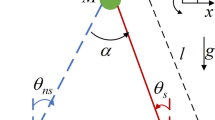Abstract
This paper investigates the stability principle underlying an underactuated compass gait generated by strict output following control of the hip-joint angle. First, we introduce a planar underactuated compass-like biped robot with semicircular feet and develop its mathematical model. We then linearize the equation of motion and design an output following control for the relative hip-joint angle of the linearized model. Second, we analytically derive the transition function of the state error for the stance phase based on the state space representation and discuss its physical meaning. We also mathematically show that the collision phase is always stable. Finally, the validity of the theoretical results is verified through numerical simulations.








Similar content being viewed by others
References
McGeer, T.: Passive dynamic walking. Int. J. Robot. Res. 9(2), 62–82 (1990)
McGeer, T.: Passive walking with knees. In: Proc. of the IEEE Int. Conf. on Robotics and Automation, vol. 3, pp. 1640–1645 (1990)
Goswami, A., Espiau, B., Keramane, A.: Limit cycles in a passive compass gait biped and passivity-mimicking control laws. Auton. Robots 4(3), 273–286 (1997)
Asano, F., Luo, Z.-W.: Energy-efficient and high-speed dynamic biped locomotion based on principle of parametric excitation. IEEE Trans. Robot. 24(6), 1289–1301 (2008)
Vukobratović, M., Stepanenko, J.: On the stability of anthropomorphic systems. Math. Biosci. 15(1–2), 1–37 (1972)
Goswami, A., Thuilot, B., Espiau, B.: A study of the passive gait of a compass-like biped robot: symmetry and chaos. Int. J. Robot. Res. 17(12), 1282–1301 (1998)
Grizzle, J.W., Abba, G., Plestan, F.: Asymptotically stable walking for biped robots: analysis via systems with impulse effects. IEEE Trans. Autom. Control 46(1), 51–64 (2001)
Coleman, M.J., Chatterjee, A., Ruina, A.: Motions of a rimless spoked wheel: a simple three-dimensional system with impacts. Dyn. Stab. Syst. 12(3), 139–159 (1997)
Asano, F.: Stability principle underlying passive dynamic walking of rimless wheel. In: Proc. of the IEEE Int. Conf. on Control Applications, pp. 1039–1044 (2012)
Asano, F., Luo, Z.-W.: Asymptotically stable biped gait generation based on stability principle of rimless wheel. Robotica 27(6), 949–958 (2009)
Asano, F.: Stability analysis of passive compass gait using linearized model. In: Proc. of the IEEE Int. Conf. on Robotics and Automation, pp. 557–562 (2011)
Acknowledgements
This research was partially supported by a Grant-in-Aid for Scientific Research, (C) No. 24560542, provided by the Japan Society for the Promotion of Science (JSPS).
Author information
Authors and Affiliations
Corresponding author
Rights and permissions
About this article
Cite this article
Asano, F. Stability analysis of underactuated compass gait based on linearization of motion. Multibody Syst Dyn 33, 93–111 (2015). https://doi.org/10.1007/s11044-014-9416-9
Received:
Accepted:
Published:
Issue Date:
DOI: https://doi.org/10.1007/s11044-014-9416-9




